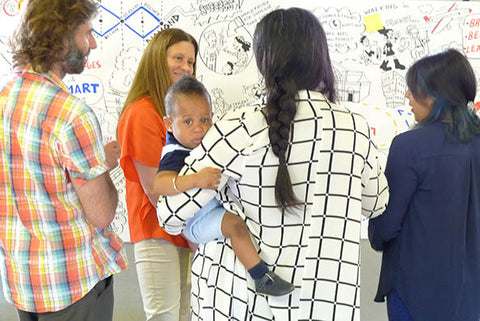
by Becky Rowe — Sep 27, 2024
How do you innovate at work if ‘being creative’ is outside your experience and comfort zone? In this article, Becky Rowe argues that the key to divergent thinking is actually better research. This requires moving beyond some traditional research methods and taking an ethnographic approach.
—
Why do innovators need better insights?
The pressure to innovate is growing across sectors. Design thinking is fast becoming an essential approach for many organisations to meet this challenge. However, knowing the theory and applying it are different things, especially as some of the skills needed can be outside people’s experience.
Most design thinking processes rely on a sequential process divergent and convergent thinking; exploration of data followed by refinement. Of the two, it’s fair to say that analytical thinking – the ‘convergent’ part of the innovation cycle – is more readily understood and people attempting design thinking are often more practiced in this area. This makes sense, many professional disciplines already depend on the ability to evaluate and ‘edit’ information, and much of the educational system is focused on developing and testing the critical thinking skills needed to do so.
By contrast, the ability to widen perspectives and uncover new possibilities is often an area where people lack experience or confidence. This is particularly problematic for design thinking processes, as shortcomings in this area – in particular the failure to do divergent thinking in a relevant, purposeful, impactful way – can sometimes undermine the whole innovation process.
So how do you master ‘divergent’ design thinking?
Firstly, successful divergent thinking relies on our individual ability to recognise that, as humans, we are all subject to strong inherent biases: our understanding of any given challenge is shaped by our own perceptions and experiences, which limit our ability to see the world in new ways. Embracing the fact that our own, individual way of thinking can be the most significant barrier to finding new ways to solve problems is fundamental to the design thinking process.

From this point of self-awareness, we need to gather insight that empowers us with different ways of understanding or perceiving the world. However, all too often ‘insight’ (especially as practiced in large organisations) is restricted to the kind found in research facilities, laboratories or surveys. Unfortunately for the divergent thinker, these kinds of ‘places’ that have often been created to capture user insight are sometimes just extensions of the very assumptions we’re seeking to overcome. In addition, the data and ‘findings’ these methods deliver can lack the vividness and detail that is required to inspire a different way of thinking.
“Firstly, successful divergent thinking relies on our individual ability to recognise that, as humans, we are all subject to strong inherent biases: our understanding of any given challenge is shaped by our own perceptions and experiences, which limit our ability to see the world in new ways.”
Real insight comes from a different ethnographic approach. It involves spending time observing and interacting with people in areas of their everyday lives. By taking the researcher and putting them into the real world, it provides us with the tools to overcome our own assumptions. Ethnography shuns artificiality, and insists that we understand the detail and vibrancy of what is actually there – real people, real lives, real places, and real experience. Almost by definition, it takes us out of our comfort zones: stretching our imaginations and maximising the impact of reality on our ideas.
As with all simple ideas, the idea of ‘studying people as they really are’ sounds almost too obvious to champion, and yet finding examples of the proper application of ethnography can be difficult. Even when it is claimed to be used, the method can be approached half-heartedly, even casually; reduced to ‘in situ interviews’, ‘pen portraits’ or a process of ‘gaining empathy’, with little investigative effort and even less robust analysis.
Embracing the fact that our own, individual way of thinking can be the most significant barrier to finding new ways to solve problems is fundamental to the design thinking process.
Despite its apparent simplicity, ethnography as a tool for divergent thinking is not an exercise to be rushed; it is a deliberate, highly rigorous discipline requiring commitment and practice.
It requires many different skills – both social and interpersonal, mixed with technical understanding and critical thinking. It requires an ability to build trust with real people from any kind of background, while remaining detached observers; it demands that we see the ‘whole picture’ while retaining the ability to respond at any time to the tiniest detail; it asks that we triangulate huge swathes of data and methodically identify the variances, commonalities or unmet needs which will serve as effective points of departure for innovation. At every point in the ethnographic process, there is a demand for intellectual curiosity and investigative determination.
For design thinkers, ethnography is an important tool to guide through the unchartered terrain of innovation; enriching our creativity and helping create a robust underpinning for bold and new ideas. And the good news is that the skills practiced by professional ethnographers are accessible to everyone.

